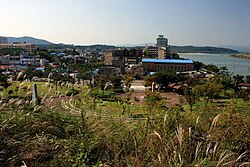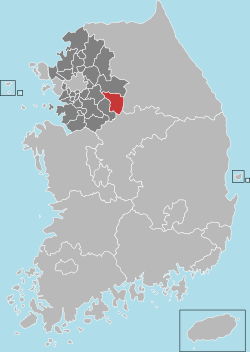Yeoju
여주시 | |
|---|---|
| Korean transcription(s) | |
| • Hangul | 여주시 |
| • Hanja | 驪州市 |
| • Revised Romanization | Yeoju-si |
| • McCune–Reischauer | Yŏju-si |
 At Yeongwollu | |
 Location in South Korea | |
| City | |
| Region | Gyeonggi Province (Sudogwon) |
| Administrative divisions | 8 eup, 3 myeon, 3 ri |
| Area | |
| • Total | 608.64 km2 (235.00 sq mi) |
| Population (September 2024[1]) | |
| • Total | 114,750 |
| • Density | 188.8/km2 (489/sq mi) |
| • Dialect | Seoul |
Yeoju (Korean: 여주; Korean pronunciation: [jʌ.dʑu]) is a city in Gyeonggi Province, South Korea. Yeoju was a county but was raised to the status of a city in September 2013.[2] Together with the neighboring city of Icheon, it is known as a major center of contemporary South Korean ceramics, and hosts the World Ceramic Exposition every year. Other local products of note include rice, sweet potatoes, and yellow melons. Yeoju is the birthplace of Korea's last queen, Empress Myeongseong.[3]
Yeoju's institution of higher learning includes Yeoju Institute of Technology. The Jungbu Naeryuk Expressway passes through the city.
A city located in the easternmost part of the southeastern part of Gyeonggi-do. It is bordered by Wonju-si, Gangwon-do to the east, Icheon-si to the southwest, Gwangju-si to the west, Yangpyeong-gun to the north, and Chungju-si and Eumseong-gun of Chungcheongbuk-do to the south. On September 23, 2013, Yeoju-gun was promoted to Yeoju-si, and it is currently the most recently promoted city in the country.
- ^ "Population statistics". Korea Ministry of the Interior and Safety. 2024.
- ^ [[s:ko:|]] 대한민국 경기도 여주군 도농복합형태의 군 등에 관한 법률 (in Korean) – via Wikisource.
- ^ Birthplace of Empress Myeongseong Archived 2013-09-27 at the Wayback Machine. 2004. Yeoju Website. 25 October 2006.
